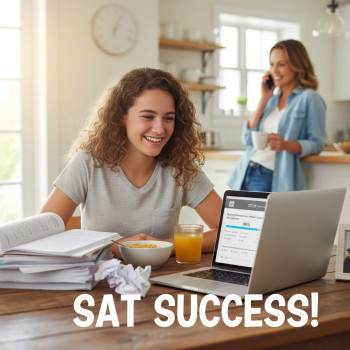Introduction: Why the Digital SAT matters for international Ivy League hopefuls
Applying to an Ivy League school feels like standing at the base of a mountain—exhilarating, daunting, and absolutely possible with the right map. For international students, the Digital SAT has become an important waypoint on that map. It communicates your readiness in a standardized way, offers an additional channel for scholarship and placement consideration, and—when used strategically—can complement your grades, extracurriculars, essays, and recommendations.

In this guide I’ll walk you (and your parents) through the smartest way to use the Digital SAT in the Ivy League application process. We’ll cover timelines, how Ivy schools treat scores, practical preparation approaches, test-day logistics, and real-world strategy examples. I’ll also show where personalized tutoring (for instance, Sparkl’s 1-on-1 guidance and tailored study plans) can make a measurable difference—especially when you have limited time and fierce competition.
Section 1 — The role of the Digital SAT in Ivy League admissions
How colleges use SAT scores
Ivy League admissions are holistic: test scores are one part of a multi-component review that includes coursework rigor, grades, letters of recommendation, essays, activities, and often interviews. That said, SAT scores still play several practical roles:
- Comparison across educational systems: Admissions officers use scores to compare students from different national curricula.
- Placement and advising: High SAT math or evidence-based reading and writing (EBRW) scores can influence course placement or advanced standing.
- Scholarships and merit considerations: While need-based aid is the norm for Ivies, some institutional programs and external scholarships look at test scores as qualification criteria.
- Optional or recommended? Policies vary: many Ivies have moved to test-optional or test-flexible periods over recent years, but strong scores can still strengthen an application—particularly when they reinforce an academic story (e.g., a top math score for a prospective engineering major).
Digital SAT specifics international applicants should know
The SAT moved to a digital format globally. Important features international students should keep in mind:
- Shorter test length, with more time per question in each adaptive module—this changes pacing and practice strategy.
- Bluebook is the testing app used at official test centers; students may need to bring their own approved device unless a center provides one.
- Score reporting and the online student score report are redesigned—reports now highlight skill-area insights and percentile comparisons by country and globally. Use these insights to target your weak points efficiently.
- Administration timing internationally may differ from U.S. dates; check registration windows early and plan to test at least once in junior year and once in early senior year if needed.
Section 2 — Timing your Digital SAT for the strongest application
When to take the test (practical timeline)
Start by thinking backward from application deadlines. For Early Action/Early Decision applicants (usually November deadlines), a safe plan is:
- Junior year spring: First full practice cycle and perhaps an actual test date (to get a baseline).
- Summer before senior year: Intensive prep, targeted practice on weaknesses.
- Early fall senior year (August–October): Final full-length official test if you need a score improvement for early deadlines.
For Regular Decision applicants (January deadlines), you have slightly more breathing room to retake the test once or twice in the fall. The key: give yourself a clear improvement window and a buffer to send scores before deadlines.
How many times should you take it?
Most successful international applicants take the SAT 1–3 times. Quality matters more than quantity—one well-prepared retake beats numerous unfocused attempts. If you’re improving by 50–80+ points with each dedicated practice cycle, an additional test can be worth it. If scores are plateauing, shift focus to other parts of the application—grades, essays, or demonstrating academic depth in other ways.
Section 3 — Building a test plan that fits your profile
Assessing your starting point
Before writing a study plan, take a timed, full-length digital practice test under realistic conditions. Use the adaptive practice tools specifically designed for the Digital SAT to capture accurate section-level insights. The student report will show: total score, section ranges, and skill-area performance—useful for prioritizing study.
Creating a focused study plan
A strong study plan balances deliberate practice with exam-specific strategy. Here’s a simple layered approach:
- Foundations (4–8 weeks): Patch knowledge gaps—grammar rules, algebraic manipulation, and reading strategies.
- Skill sharpening (6–10 weeks): Targeted problem sets in your weakest skill areas identified by practice reports.
- Test simulation (4–6 weeks): Full digital practice under Bluebook-like conditions and timed sections.
For international students juggling school and application tasks, personalized tutoring can compress this timeline. Sparkl’s 1-on-1 tutoring—if you choose to work with a service like that—often pairs tailored study plans with AI-driven insights and expert tutors who adapt practice content to your schedule. That kind of targeted help is especially useful when English isn’t your first language or when national calendars make multiple test dates hard to schedule.
Section 4 — Strategic score use in applications
Which score to send and when
Most colleges allow score choice (you send the test dates you want considered); others superscore or consider the highest section scores across test dates. For international applicants:
- If you have one clear best test date, send it early—before restrictions or deadlines are near.
- When colleges superscore, focus on improving individual sections—sometimes a big jump in math alone can shift an admission decision.
- If your scores are borderline relative to target averages, use them to tell a strong academic story in essays and recommendations (e.g., “my SAT math score reflects focused competition math training”).
Contextualizing scores for admissions officers
Admissions officers know international grading systems vary. Use your application to provide context—briefly note course rigor, competitive exam scores (if any), and why your SAT performance is representative of your academic potential. A high SAT score combined with international awards, national exam distinctions, or research signals can elevate an application’s credibility.
Section 5 — Practical preparation tactics (reading, writing, math)
Reading & writing: not just vocabulary
The Digital SAT reading and writing questions emphasize comprehension, evidence-based reasoning, and editing. International students should:
- Practice active reading: summarize paragraphs in one sentence and identify an author’s purpose quickly.
- Drill evidence questions: practice finding lines that support answers and cross-checking choices against the passage.
- Polish grammar and usage rules common to the SAT—parallel structure, verb tense, and punctuation habits are frequent traps.
Math: focus on fluency and problem structure
Math on the Digital SAT rewards fluency and clear, efficient problem structure. Tips:
- Memorize core algebra, geometry, and basic statistics formulas so you don’t waste time deriving them.
- Practice with the embedded Desmos-style calculator and the test’s calculator options—digital testing now allows calculator versatility, so simulate that in practice.
- Work backward for some multiple-choice items: plug choices into the question to find the correct answer quickly.
Study routine checklist
- One timed digital section practice 3–4 times per week.
- Two focused skill-building sessions per week (ex: sentence corrections, algebra functions).
- Weekly full-length practice every 2–3 weeks in the months leading up to the test.
- Regular review of errors with a log: identify patterns, not just single mistakes.
Section 6 — Test-day logistics for overseas applicants
Booking, identification, and the testing device
International test centers may have earlier or different registration windows. Book early to secure a seat. Important logistical notes:
- Bring the identification required by the test center—your passport is the standard ID for international testers.
- Confirm whether the center expects you to bring your own device for Bluebook or will provide one. If you bring a device, ensure it meets the stated technical requirements and is charged; familiarize yourself with the Bluebook app in advance on an approved device.
- Arrive early and bring an approved calculator (if you prefer handheld) and any allowed accessories. Check the most recent College Board guidance for prohibited items.
Handling test anxiety and unforeseen issues
Technical glitches or nerves happen. Practicing in a Bluebook-like environment reduces the chance of panic. If a technical issue occurs, proctors have scripts and procedures to follow; remain calm and report the problem immediately. For nerves, incorporate breathing routines, short mindfulness exercises, and a light warm-up sudoku or reading passage before the test to get into focus.
Section 7 — Presenting a strong overall application beyond scores
Essays, recommendations, and extracurricular depth
An Ivy-worthy application tells a coherent story. SAT scores can support that story but don’t replace it. A few practical strategies:
- Use the personal statement to show intellectual curiosity, not test prowess. Link academic passions to real work—projects, research, competitions, or community impact.
- Ask recommenders who can speak to your academic potential and character in context—teachers who know you well academically are usually the best choice.
- Depth over breadth: demonstrate meaningful commitment, leadership, or creativity in a few areas rather than listing many shallow activities.
Using SAT strength to reinforce academic focus
If your SAT performance highlights a particular strength (e.g., math), weave that into your academic narrative: planned major, research interests, or an independent project. Admissions officers appreciate when test scores align with demonstrated interests—they become evidence, not just numbers.
Section 8 — Sample schedules and score targets
Realistic score target table
Below is a simple table that maps target SAT score ranges to strategic goals for international applicants aiming at Ivy League or similar highly selective schools. Use it as a planning guide—not a guarantee.
| Score Range (Total) | Practical Meaning | Application Role |
|---|---|---|
| 1500–1600 | Elite competitive range | Strong differentiator; supports any major choice |
| 1450–1490 | Highly competitive | Excellent for STEM and quantitative majors when combined with strong grades |
| 1400–1440 | Competitive | Solid applicant; bolster with strong essays and extracurriculars |
| 1300–1390 | Good | Consider retake if possible; focus on unique application strengths |
| Below 1300 | Area for improvement | Plan targeted prep and consider retake; emphasize other components |
Example 6-month study calendar (compact)
- Month 1: Diagnostic test and foundation review (basics in grammar and algebra).
- Month 2–3: Focused skill drills (reading strategies, evidence questions, algebra II, functions).
- Month 4: Mixed timed sections and error log deep dive.
- Month 5: Full-length digital practice tests (one every 7–10 days) and test strategy refinement.
- Month 6: Light review, rest, and final simulation a week before the test.
Section 9 — How personalized tutoring can help international applicants
When 1-on-1 coaching is worth it
Personalized tutoring is most valuable when you need targeted gains quickly or when English language differences make test strategies less intuitive. Tutors can:
- Analyze digital practice reports and create a tailored skill plan.
- Teach techniques specific to the Digital SAT’s adaptive structure and Bluebook interface.
- Provide accountability and timed mock testing with feedback.
Services like Sparkl offer 1-on-1 guidance, tailored study plans, expert tutors, and AI-driven insights that can speed improvement by focusing on the exact content areas blocking score gains. For many international applicants juggling school exams and application tasks, that precision saves both time and stress.
Section 10 — Real-world examples and quick case studies
Case study A: The math-focused applicant from India
A prospective engineering student scored 1420 on an initial Digital SAT (760 math, 660 EBRW). With an 8‑week focused program emphasizing problem-solving speed and calculator strategies, plus targeted essay coaching to link math interest to research experiences, the student raised the total to 1520 and received an affirmative discussion in admit committees at reach schools. Outcome: improved admissions prospects and stronger scholarship conversations.
Case study B: The non-native English speaker from Brazil
Starting score: 1280 (710 math, 570 EBRW). Approach: 12 weeks of 1-on-1 tutoring focusing on reading comprehension strategies, active vocabulary in context, and writing mechanics, combined with weekly full-digital practice tests. Result: total jumped to 1400; essays emphasized research and volunteer work, strengthening the overall application narrative.
Section 11 — Final checklist for international applicants
- Register early and confirm test-center device policy.
- Take at least one full digital practice test under Bluebook-like conditions.
- Create a study calendar with measurable checkpoints (weekly score goals, skill targets).
- Keep an error log—identify patterns and repair them deliberately.
- Consider targeted 1-on-1 tutoring if you need a fast, efficient score increase—Sparkl-style personalized plans work well here.
- Use SAT strengths strategically in your application essays and recommendation context.
- Leave time for at least one final test or alternate evidence (like AP/IB scores) if your first attempts don’t land where you need them to be.
Conclusion: Turn the Digital SAT into an advantage
Think of the Digital SAT not as a hurdle, but as a tool you can use to tell a clearer academic story to Ivy League admissions committees. For international students, a strong SAT performance can bridge unfamiliar grading contexts, highlight academic readiness, and complement other application strengths. With smart timing, disciplined practice, and—when helpful—targeted personalized tutoring that provides 1-on-1 guidance, tailored study plans, expert tutors, and AI-driven insights, you can turn each test sitting into forward momentum.
Take a breath, plan deliberately, and remember that the SAT is only one dimension of your candidacy. Use it to reinforce your real strengths: curiosity, persistence, and the specific contributions you’ll bring to campus. Good luck—the mountain is steep, but you don’t have to climb it alone.














No Comments
Leave a comment Cancel